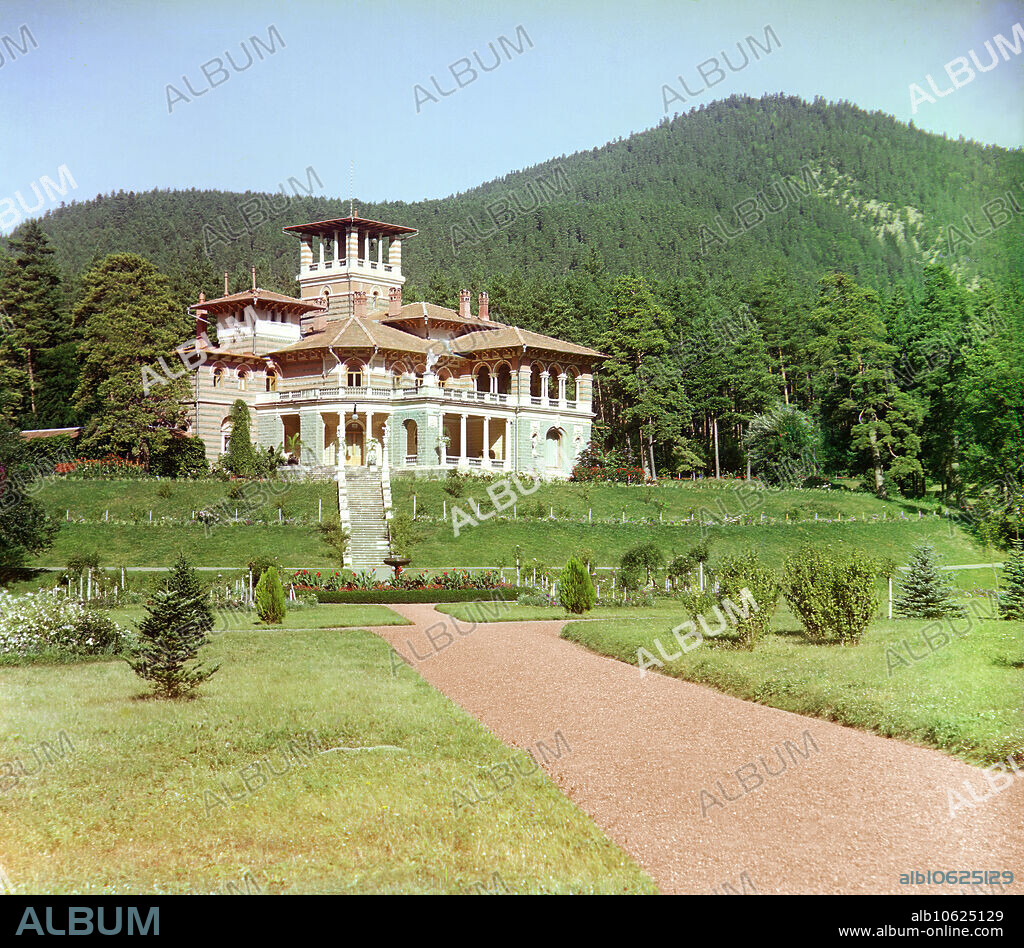alb10625129
SERGEY MIKHAYLOVICH PROKUDIN-GORSKY. General view of the Likanskii Palace from the Kura River, between 1905 and 1915. Creator: Sergey Mikhaylovich Prokudin-Gorsky.

|
Add to another lightbox |
|
Add to another lightbox |



Buy this image.
Select the use:

Title:
General view of the Likanskii Palace from the Kura River, between 1905 and 1915. Creator: Sergey Mikhaylovich Prokudin-Gorsky.
Caption:
General view of the Likanskii Palace from the Kura River, between 1905 and 1915. The Likany foothills of the Caucasus Mountains provide a dramatic backdrop for a palace built on the Kura River, close to the Russian border with Turkey and near the town of Borzhomi in present-day Georgia. The Romanov Palace, also known as Likani Palace, was designed by Leon Benois for {/30401/}. Russian chemist and photographer Sergey Prokudin-Gorsky (1863-1944) was a pioneer in colour photography which he used to document early 20th-century Russia and her empire, including the vanishing way of life of tribal peoples along the Silk Route in Central Asia. In a railway-carriage darkroom provided by Czar Nicholas II, Prokudin-Gorsky used the three-colour photography process to record traditional costumes and occupations, churches and mosques - many now Unesco World Heritage sites - as well as modernisation in agriculture, industry and transport.
Technique/material:
Photograph
Credit:
Album / Heritage Art/Heritage Images
Releases:
Image size:
4960 x 4336 px | 61.5 MB
Print size:
42.0 x 36.7 cm | 16.5 x 14.5 in (300 dpi)
Keywords:
1900S • 1910S • 1990S • 20TH CENTURY • 90S • ARCHITECTURE • ASIA • BORJOMI • BUILDING • BUILDINGS • CENTURY • COLOR SEPARATION NEGATIVES • COLOR • COLOUR • CONGRESSIONAL LIBRARY • COUNTRY • EXTERIOR • FLUSH • GARDEN • GARDENS • GEOGRAFIA • GEOGRAPHICAL FEATURE • GEOGRAPHY • GEORGIA • GLASS NEGATIVES • GRAND DUKE NICHOLAS MIKHAILOVICH OF RUSSIA • GRAND DUKE NICHOLAS • GRAND DUKE NIKOLAI MIKHAILOVICH • GRAND DUKE NIKOLAY MIKHAILOVICH • HILL • HILLS • HOUSE • HOUSES • LANDSCAPE • LANDSCAPES • LIBRARY OF CONGRESS • LIBRARY • LIKANI PALACE • LIKANI VILLA • LOCATION • MEETING OF FRONTIERS • NICHOLAS MIKHAILOVICH ROMANOV • NICHOLAS MIKHAILOVICH • NIKOLAI MIKHAILOVICH ROMANOV • NIKOLAY MIKHAILOVICH ROMANOV • NINETIES • NINETIES, THE • NINETY DECADE • OUTDOOR • OUTDOORS • OUTSIDE • PALACE • PHOTOGRAPH • PROKUDIN-GORSKY • PROKUDIN-GORSKY, SERGEY MIKHAYLOVICH • ROMANOV PALACE • ROMANOV • RUSIA • RUSSIA • RUSSIAN • SERGEI MIKHAILOVICH PROKUDIN-GORSKY • SERGEI PROKUDIN-GORSKY • SERGEI • SERGEY MIKHAYLOVICH PROKUDIN-GORSKY • SERGEY MIKHAYLOVICH • SERGEY PROKUDIN-GORSKY • SERGEY • STILL IMAGE • TOURISM • TOURIST ATTRACTION • TRAVEL • VILLA


 Pinterest
Pinterest Twitter
Twitter Facebook
Facebook Copy link
Copy link Email
Email
